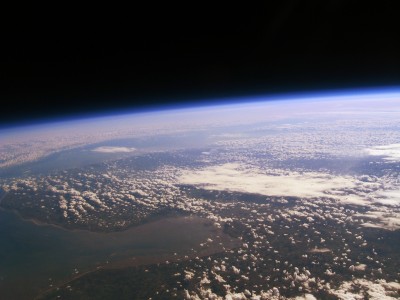When I was kid, I often dreamed of attaching a camera to a balloon and flying it as high as it would go. But much to my chagrin at the time, crucial components for such a homemade undertaking were not yet available to the average school boy. At the time, commercial or military guidance systems and suitable cameras were beyond the means of the starry-eyed kid that I was.
Today of course, we have mass produced GPS receivers and cheap digital cameras. And now, Robert Harrison, a British amateur photographer has surprised the world with his stunning images of Earth, taken from the edge of space.
The technology could not be cheaper and simpler: a helium balloon, a simple digital point-and-shoot camera, and a tracking system using a commercial GPS receiver is all Harrison needs to snap amazing pictures. And the marvel of Google Maps allows free flight tracking. All for the combined cost of about $750!
Harrison’s image gallery is here, and his personal web site is at:
Harrison, a computer engineer, lives in Highburton, West Yorkshire — which strikes me as an unlikely place from which to launch space missions. Since 2008, his contraptions have flown about 20 times. The camera used (a Canon A560) is very similar to one I own.
So where does “space” really begin? The question is not so easy to answer, because the Earth’s atmosphere does not simply “end” at a clearly defined elevation. It becomes gradually thinner. The further away one gets from Earth, an increasing number of air molecules escape the Earth’s gravity and magnetic field and drift away from our planet.
By international convention, “space” is presumed to begin at an elevation of 100 km (or 62.1 miles) — the so-called Kármán Line. Even higher, at 75 miles, space vehicles returning to Earth hit aerodynamic drag. But this is more attributable to the enormous speed at which a vehicle must travel when in orbit. The atmosphere’s density at such elevations is so thin that it is practically qualifies as an almost perfect vacuum.
But there are other definitions of “space”. For example, in the U.S., a person is presumed to be an “astronaut” after traveling 50 miles (or about 80 km) above the mean sea level. By that definition, a number of military test pilots have reached space as early as the 1960s while traveling in winged aircraft, and before many NASA astronauts traveling on ballistic rockets.


